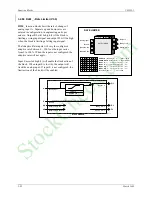
Function Blocks
UM353-1
March
2003
3-86
POWER UP - During a warm or cold power up, the output will be initialized to MINSCALE and all dynamic
elements will be initialized at the current input on the first scan.
Input AG is multiplied by the gain error (GE). In version 1.30 of the controller firmware, an unconnected AG input
will be set to 1.0. In earlier versions, it was set to 0.0 which required that the input always be connected to a source
(e.g. Hold block) in order for the PIDAG block to function.
The controller output has MINSCALE and MAXSCALE parameters allowing the output signal to be scaled for
engineering ranges other than the default of 0 - 100 PRCT. This may be necessary when the controller output is the
setpoint to another controller.
The Autotune feature is accessible using the TUNE pushbutton when AUTOTUNE is set to YES and can be
initiated while the loop is in Auto or Manual. The autotuner, when initiated, replaces the PIDAG with an on-off
control function, places the A/M block in Auto (if in Man) and cycles the control loop through six on-off cycles
while learning the process dynamics which it uses to provide tuning recommendations for the PIDAG controller.
The % DEV parameter is the maximum amount in % that the process should deviate from the setpoint during the
on-off cycles. This parameter can be set manually or can be configured as AUTO. When AUTO is configured, the
autotuner will set the % DEV to 4 times the % HYS. This is the minimum value needed to provide good autotuning
results.
The % HYS parameter is the amount that the process must deviate from setpoint before switching the output in the
opposite direction. This value must be at least equal to or slightly greater than any process noise band. If the noise
band cannot be determined, the autotuner will compute it at the start of an autotuning exercise when the % HYS
parameter has been configured as AUTO.
The % STEP parameter is the amount that the valve will change on the first on-off cycle. After the first cycle, the
autotuner will adjust the step to keep the process within the value of the % DEV parameter. On subsequent
autotune exercises, the step will use the value computed from the previous exercise unless the AT RESET parameter
is set to YES or the controller has been power cycled. The dynamic response recommended by the autotuner can be
configured as Fast, Medium, or Slow. The Medium setting will normally provide a response that has no or little
overshoot to a setpoint step response.
When the POST AT parameter is set to YES, the control loop will be returned to Auto using the recommended
tuning values unless a warning occurred during the test.
More details on autotuning can be found in the Operation section.
StockCheck.com
Содержание Moore 353
Страница 2: ...S t o c k C h e c k c o m ...
Страница 14: ...Contents UM353 1 xii March 2003 S t o c k C h e c k c o m ...
Страница 24: ...Introduction UM353 1 March 2003 1 10 S t o c k C h e c k c o m ...
Страница 152: ...LonWorks Communications UM353 1 March 2003 5 4 S t o c k C h e c k c o m ...
Страница 164: ...Network Communications UM353 1 6 12 March 2003 S t o c k C h e c k c o m ...
Страница 246: ...Operation UM353 1 March 2003 9 8 S t o c k C h e c k c o m ...
Страница 254: ...Controller and System Test UM353 1 March 2003 10 8 S t o c k C h e c k c o m ...
Страница 282: ...Circuit Description UM353 1 March 2003 13 4 S t o c k C h e c k c o m ...
Страница 298: ...Model Designation and Specifications UM353 1 March 2003 14 16 S t o c k C h e c k c o m ...
Страница 302: ...Abbreviations And Acronyms UM353 1 15 2 March 2003 S t o c k C h e c k c o m ...
Страница 304: ...Warranty UM353 1 W 2 March 2003 S t o c k C h e c k c o m ...
















































